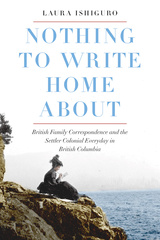
Urbanizing Frontiers
Indigenous Peoples and Settlers in 19th-Century Pacific Rim Cities
Urbanizing Frontiers explores the lives of Indigenous peoples and newcomers in two Pacific Rim cities – Victoria, British Columbia, and Melbourne, Australia. Built on Indigenous lands and overtaken by gold rushes, these cities emerged between 1835 and 1871 in significantly different locations, yet both became cross-cultural and ultimately segregated sites of empire. Victoria’s population came to include large numbers of Indigenous peoples, a legacy of the fur trade, whereas Melbourne’s Indigenous population was far smaller. An explanation lies in the structural features of the fur trade versus pastoralism, and the ensuing politics of race that played out at the spatial, imaginative, social, and legal levels, where bodies and spaces were rapidly transformed, sometimes in violent ways.
This innovative, interdisciplinary study reconceptualizes the frontier as urbanizing space by charting the development of the settler-colonial city and exploring the lives of the newcomers, Indigenous peoples, and mixed-race peoples who, in turn, shaped its development. It will be of interest to students and scholars of colonialism, urbanism, Indigenous studies, transnational history, cultural geography, and Pacific Rim studies.
It will be of interest to students and scholars of colonialism, urbanism, Indigenous studies, transnational history, cultural geography, and Pacific Rim studies.
Urbanizing Frontiers is a fine example of comparative colonial history. This sort of history requires research in multiple locations often separated by vast distances, engagement with the historiographical contours of at least two countries, and a conceptual language to bridge them. ...[it shows] rich and compelling evidence or the insightful analysis which is developed with reference to postcolonial, feminist and spatial theory.... Urbanizing Frontiers is a sophisticated monograph, carefully crafted and impressive in scope. It deserves a wide readership in indigenous studies, colonial history, urban history and historical geography, while also making an important and timely contribution to both Australian and Canadian history.
Edmonds argues for a redefinition of perhaps the most contested idea in settler colonial historiography: that of the frontier….and offers a devastating indictment of the urban biopolitics of settler colonialism and their effect on Indigenous society.
Taking as her case studies Victoria on Canada’s west coast and Melbourne, Australia, Edmonds makes a compelling case for the ways in which urban and indigenous histories are deeply entwined..[with] insightful placements of the potlatch and the corroboree alongside the grid and the picturesque ... the urban stories she tells are rich, complex, and densely critical ... Urbanizing Frontiers is an outstanding contribution to the nascent literature on urban colonialism and indigenous peoples.
This is an important book, a must read not only for scholars in Native studies, but for urban historians as well. Indeed, I found myself excitingly quoting from it and footnoting it while preparing a manuscript before I could sit down and systematically read it for the purposes of this review ... One of the strengths of this book, indeed, is Edmonds’ nuanced analysis of gender. We not only see indigenous women in a wide variety of roles in both places from oyster traders to victims of sexual abuse, we also see how critical gender was in the discursive construction of place
Urbanizing Frontiers sheds much-needed light on the spatial mobility of the developing settler colonial city where ‘mutual, albeit uneven, interactions, of colonization and Indigenization were, for a short time part of the tenor of the early settler-colonial landscape’. Edmonds is truly interdisciplinary in her research and conceptualisation of these two sites and she makes an important contribution to the understanding of Australian and Canadian history, as well as the other discourses of colonialism, race and urban geography.
An excellent work of comparative colonial history...the casual reader of British Columbian or Australian history as well as the academic of urban studies, policy, urban geography, colonial, gender and race history should consider reading this book.
This book makes an original and highly important contribution to the specific historiographies of Canada and Australia, as well as the broader literatures on colonialism, urban development, and race ... Transnational comparative analysis is an increasingly important approach to understanding the past, especially in the study of colonialism and settler-indigenous relations, and to my knowledge no other study with this scope and theoretical bent has been published.
Acknowledgments
Introduction
1 Extremities of Empire: Two Settler-Colonial Cities in Comparative Perspective
2 Settler-Colonial Cities: A Survey of Bodies and Spaces in Transition
3 "This Grand Object": Building Towns in Indigenous Space [Melbourne, Port Phillip]
4 First Nations Space, Protocolonial Space [Victoria, Vancouver Island, 1843-58]
5 The Imagined City and Its Dislocations: Segregation, Gender, and Town Camps [Melbourne, Port Phillip, 1839-50]
6 Narratives of Race in the Streetscape: Fears of Miscegenation and Making White Subjects [Melbourne, Port Phillip, 1850s-60s]
7 From Bedlam to Incorporation: First Nations Peoples, Public Space, and the Emerging City [Victoria, Vancouver Island, 1858-60s]
8 Nervous Hybridity: Bodies, Spaces, and the Displacements of Empire [Victoria, British Columbia, 1858-71]
Conclusion
Notes
Bibliography
Index








